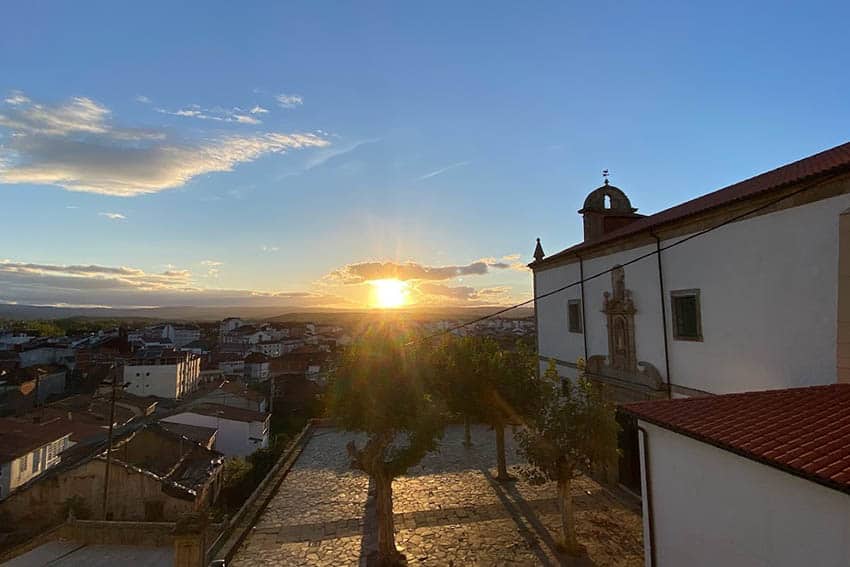
The Lesser Traveled Winter Way: It Might Be Spain’s Best-Kept Secret
By Abbey Algiers
It was a walking stick that had brought me here, to this final point of my journey along Spain’s Camino de Santiago – a network of pilgrimage routes all leading to the Cathedral of St. James in Santiago.
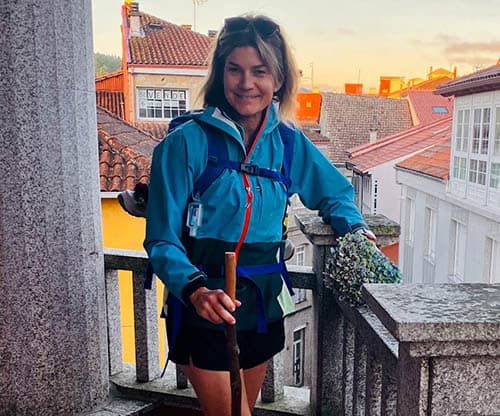
I was at the Pilgrim’s Office, waiting to get my certificate of completion or “Compostela” that proved I’d met distance requirements on my journey to Santiago.
The significance of the Compostela wasn’t lost on me, for it represented a physical, spiritual, and emotional journey traveled by pilgrims since the 9th century.
Holding on to the Stick
As I waited, I held onto the wooden walking stick that had guided me through Spain’s northwest province of Galicia along the Camino de Invierno, or “Winter Way.”
It had been the journey of a lifetime, where 13 of us – a mix of family and friends – quickly bonded and became a true “Pilgrim Family.”
The trip had been full of magical moments hinting that there’s more to life than we realize.
I wondered if that magic was due to my walking stick or “Camino Magic,” a phenomenon that pilgrims of the Camino de Santiago often experience but can’t quite describe.
There’s a Why Behind Every Camino
Whether it was “Camino Magic” or otherwise, the stick symbolized the reason behind my Camino. It was made by my dad, who had given it to me when I told him about my hope to one day do the Camino.
He handed it over, saying, “Take it; it’s yours. Use it on the Camino someday. I wish I could do it too, but carry it, and I’ll be there with you.”
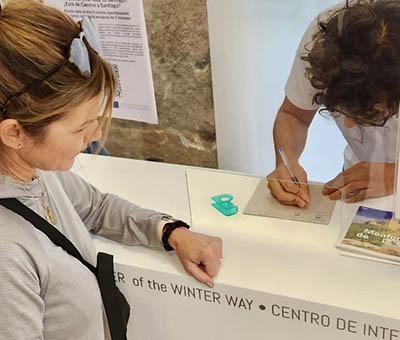
I gratefully took the stick and hoped that whenever I ended up using it, I’d be able to report back to him about my experience.
Loss of Parents
Unfortunately, that wasn’t the case, as both my dad and mom passed in 2020. The loss of each, mixed with the chaos and confusion of 2020, had left me needing renewal even as things started to get back to normal in the world.
So, given the opportunity to do the Camino with my brother, sister-in-law, niece, nephew, and other family and friends this fall, I knew I had to do it.
Back in the Pilgrim’s Office, I scanned the room, noting pilgrims from all over the world. I knew each pilgrim came with unique and deeply personal reasons for their Camino.
Soon we’d all be asked about those reasons on the Compostela form, selecting from the options of “religious, religious and other, or not religious.”
The Benefits of the Road Less Traveled
Since our group only had a week to walk, we picked up the Camino de Invierno near Monforte de Lemos, making our distance to Santiago 135 kilometers instead of 263 kilometers from the official starting point in Ponferrada.

Also known as “The Winter Way,” the route was created for pilgrims traveling in the winter who wanted to avoid the mountains of O Cebreiro and for pilgrims traveling at peak times who prefer a less crowded route – a fact I’d soon learn was perfect for our group.
Initially, I had wished our group had chosen one of the more popular routes – I worried that fewer pilgrims on the route would make it feel like less of a pilgrim experience.
It turns out this fear would teach me an important Camino lesson, “The Camino doesn’t give you what you ask for; it gives you what you need.” As it turned out, the lesser traveled route was perfect for our group.
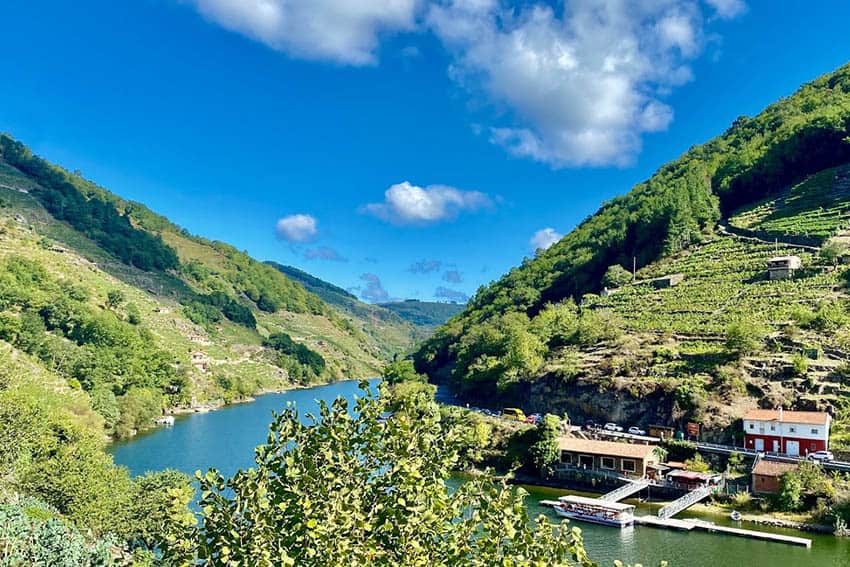
From the very first day, we found that a quieter Camino is perfect for small groups or pilgrims looking for solitude.
Due to the low number of pilgrims on the Camino de Invierno, our group was essentially alone on the trail the entire week, with the exception of meeting a few pilgrims here and there.
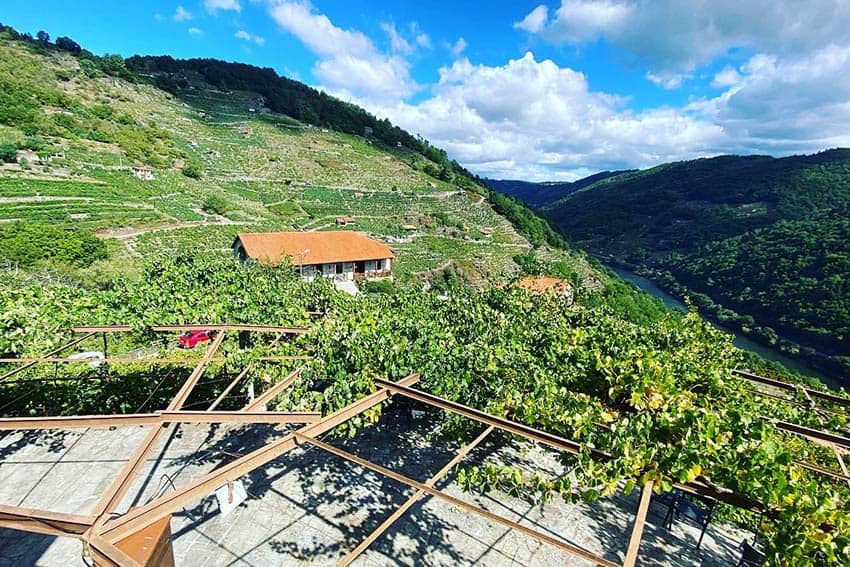
This helped us maintain comfortable distances yet stick together, thus maintaining the perfect amount of space to ebb and flow between conversations and have time alone with our thoughts.
I can’t imagine the same group connection had we been on a route with more people, where it might have been more difficult to keep track of each other.

As we made our way to villages and stopped in bars and restaurants, we stood out as pilgrims among Spaniards rather than pilgrims blending in with the crowds of other pilgrims on more populated routes.
We found the Spaniards treated us like VIPs, offering advice and information about the culture and area. This happened on our first day when we stopped for lunch at a family-owned restaurant/winery in the mountains between Montforte de Lemos and Chantada.
Our group practically took over a glass-enclosed porch overlooking the hillside and vineyards below.
Here, the waitress explained each course of our typical Galician “pilgrim’s meal,” shared the history of her family’s 100-year-old restaurant and winery, and told us about the region surrounding it.
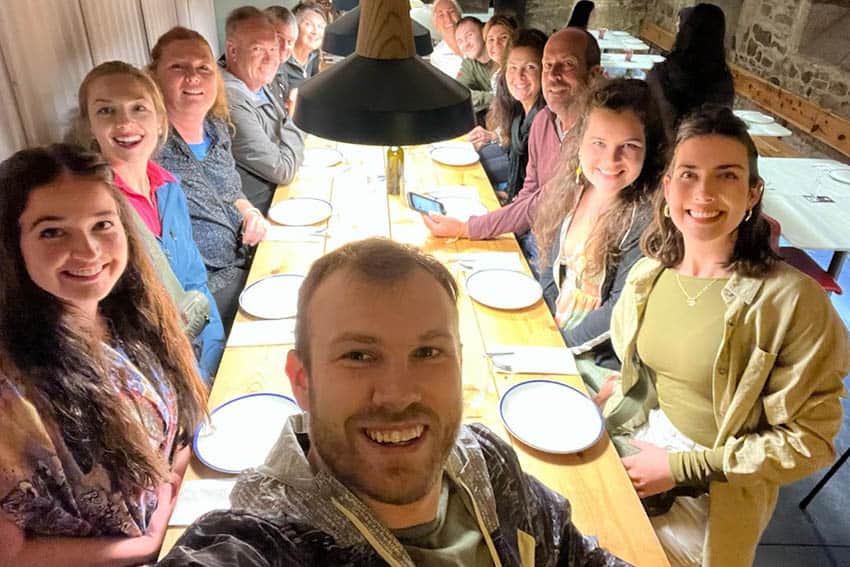
Learning the Ropes
Since we were all rookies, we initially relied on the information we learned from guidebooks, online research, a Camino de Invierno app, and former pilgrims. However, the experience proved to be our best teacher, as we quickly learned things like the value of the words “pack lightly.”
Our packs were heavy, and since the Winter Way has its fair share of uphill climbs, some opted to lighten our loads by the second or third day. We took advantage of the taxi service available along the Camino and had some of our gear sent ahead of us by taxi each day.

Another important fact about the Camino de Invierno – villages can be few and far between on some stretches. We quickly learned it was best to carry lunch with us instead of relying on restaurants.
Again, this proved perfect for our group, as it gave us a chance to have picnic lunches with bread, Spanish cheese and meats, and fruits (pears, grapes, figs) that we picked along the way.
The Camino and Its Power to Connect Us
To say the Camino helps you get to know those you’re traveling with is an understatement. While I knew most of the people in my group (after all, some were family), a few were new to me, and others I hadn’t seen in years.
The Camino took us from being a group of “traveler-friends” on Day 1 to a tight-knit “Pilgrim Family” by the end of Day 2 after we had tackled a 19.4-mile, mostly uphill hike on the Winter Way.
Throughout the week, we found that the Camino, like travel in general, offers many opportunities to get to know ourselves and those we’re traveling with.
Sometimes it meant getting to the bottom of a deeply personal issue while walking solo. Other times, the time and space on the Camino allowed for tough conversations that should’ve been had years ago.
It’s almost like you think, “if we can’t get to the bottom of this on the Camino… then when will we ever?”
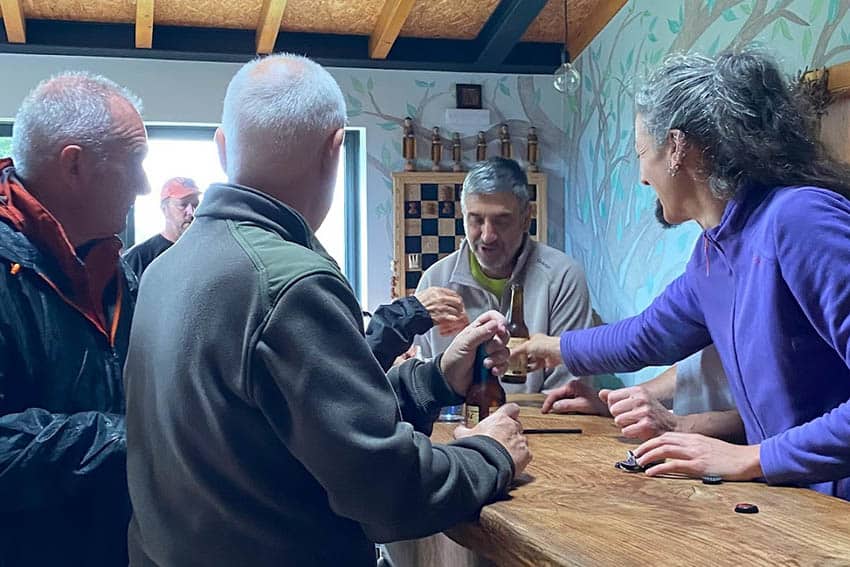
Time took on new meaning on the Camino, and we began to truly live in the moment and have impactful experiences with others that we probably wouldn’t take the time to do in our daily lives.
In addition, we met Spaniards along the way – like the Mother/Daughter duo Montse and Irina of the MON ComeySueña Guesthouse in Monforte de Lemos. Here we saw how a family worked to create a beautiful hotel where care, creativity, and style went into every detail.
Their positive energy attracted not only pilgrims but villagers as well, evidenced by the packed bar at breakfast on the day we were leaving.

During the morning rush, Montse remained attentive and cheerful as she somehow checked our group out of our rooms, took money for breakfasts, took breakfast orders, and made coffee.
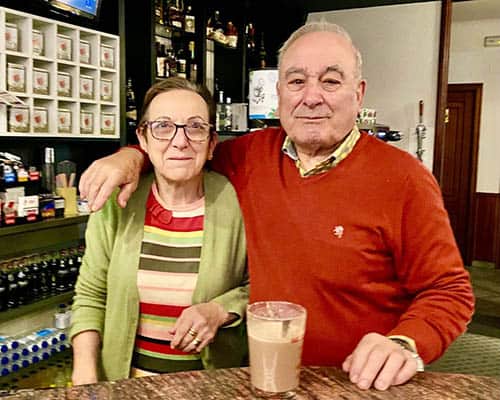
She then took the time to stop everything as our group was leaving to give us hugs and left us with a warm “Buen Camino” – the typical salutation said on the Camino meaning “have a good walk.”
The remarkable hospitality continued at our next hotel in the village of Rodeiro, where Luis and Marisa, and their adult children, Jose Luis and Marta, welcomed us to their Hostel y Albergue Carpinteiras.
From the moment our group of 13 overtook their lobby, we felt like “guests” rather than just people staying at their hostel.
The family did everything in their power to make our overnight stay perfect.
They checked us into our rooms, made dinner reservations for us, served us drinks and perhaps the best potato chips I’ve ever eaten, and arranged a taxi service for our excess baggage the next day.
The (affordable) hostel and albergue (dormitory) accommodations were immaculate, freshly decorated, and included breakfast.
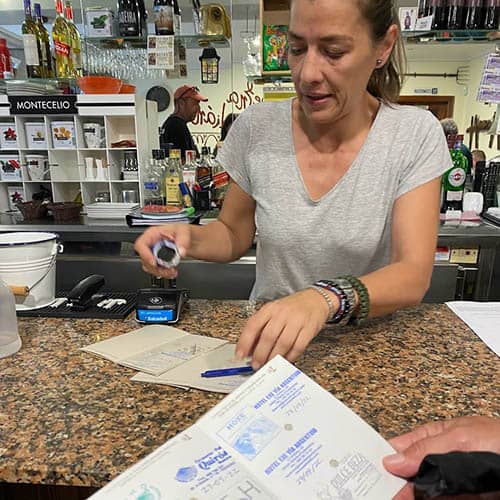
We continued to have positive interactions with Spaniards everywhere we stayed as the owners welcomed us in and shared their stories.
Take Ana, the owner of A Taberna de Gundián in the village of Vedra, a hotel and restaurant that she’ll run by herself until her husband returns from serving his tour in Iraq.
She explained that she’d only owned the property for 14 months and did everything solo. Her efforts were seen in the spotless & beautifully decorated rooms, delicious pilgrim meal, and breakfast-to-go she provided us.
We also discovered that sometimes pilgrims on the Camino get a calling to stay on the Camino, like the Italian couple Andrea and Cristina.

They were the owners of Casa Leiras, an albergue & cafeteria we had stumbled upon one day.
Over our group’s mid-day break, Cristina told me how she and her husband had been doing the Camino in 2007 when they happened upon a farm for sale.
Inspired, they bought it, moved to Spain, and restored the house and barn to be the gorgeous countryside albergue and cafeteria Casa Leiras.
Traveling Through Galicia
Our journey along the Camino de Invierno introduced us to all of Galicia – its terrain, climate, and nuances.
We learned how to dress for the region – in layers as temperatures inevitably rise as the day progresses, and always with rain gear on hand, for Galicia can be rainy.
We felt as if we were going back in time as we walked through small villages where trucks still delivered bread to villagers, and dogs greeted us upon arrival.
We saw pastures with wild horses and country roads where cattle roamed freely, and shepherds herded sheep.
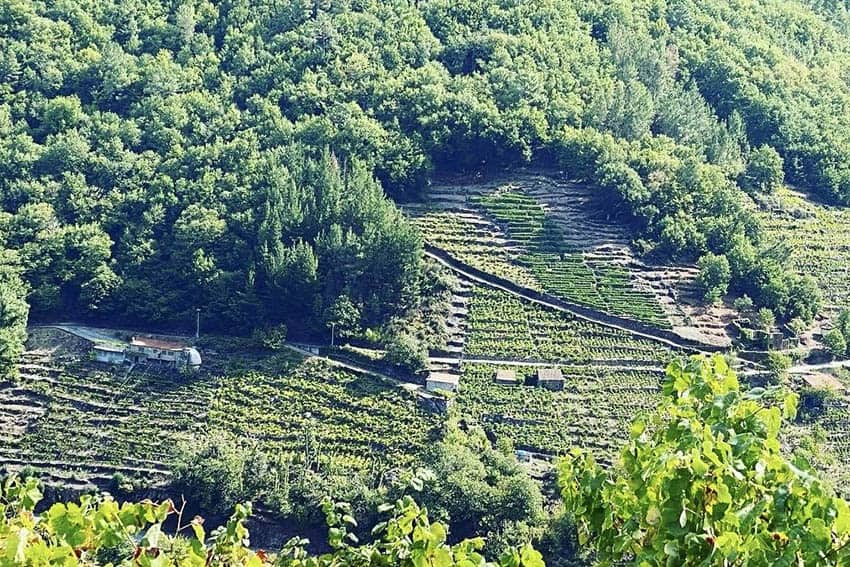
We carefully plodded down rugged, rocky paths and walked through forests blanketed by trees, beautiful flowers, and berries. We witnessed the beauty of the Ribeira Sacra wine region and sampled its grapes and wines.

The Camino allowed us to experience the culture and cuisine of Galicia and learn about Galicia’s four provinces – La Coruña, Lugo, Orense, and Pontevedra, as the Camino de Invierno is the only route that goes through all four.

We enjoyed the region’s “pintxos” (appetizers), such as empanadas, croquetas, tortilla española, padron peppers, and various small toasts with seafood.
Meals always came with bread and a salad, a heartier main dish such as stew, seafood, or a variety of meats.
Meals on the Winter Way were often topped off with a traditional dessert of the area, the “Tarta de Santiago,” a cake featuring the Cross of St. James and made with almonds, eggs, sugar, and a splash of brandy.
Galician Cuisine
In addition to daily doses of Galician cuisine, we found ourselves walking into village festivals, which are typical throughout Spain.
We stumbled upon a “pulpo” or octopus festival in one village, where caldrons of octopus were being boiled outside restaurants, and discovered a festival in another town that was complete with a carnival, concert, and Spanish food.
The beauty of traveling by foot is that it allows us to literally walk into the lives of the Spanish people and get a first-hand look at their traditions and celebrations.
The Long-Lasting Effects of the Camino de Santiago and the Winter Way
As I reflected on my time on the Camino de Invierno and the Winter Way, I realized that it’s impossible to walk away from the experience and not feel the metamorphosis that has taken place.
The Camino changes people, and as many pilgrims attest, I feel I’ve only cracked the surface on my journey. In fact, most pilgrims feel that the Camino doesn’t end in Santiago… it only just begins. The Winter Way gives more people the chance to have this amazing feeling.
This could explain why many are called to come back again and again, each time hoping to gain new clarity and enlightenment.
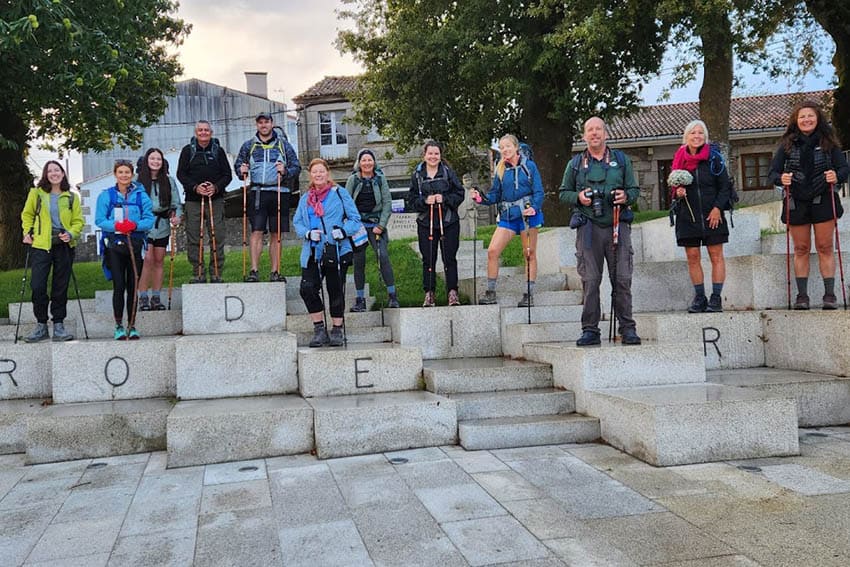
But regardless of whether we return to Santiago, we leave knowing that wherever the road of life takes us, we are absolutely not alone – there are people and forces always accompanying us, even during the darkest days… and also, walking sticks, there for us to lean on to face whatever lies ahead on our path.
¡Buen Camino!
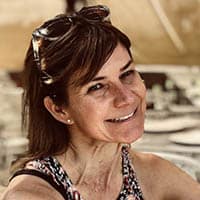
Abbey Algiers is a freelance writer based in Wisconsin and has had an affinity for travel since her first trip to Spain at age nine. She’s been a contributor for Youth on Course, the LPGA Women’s Golf Network, Diverbo Language Immersion, and various travel publications. When not behind the computer or planning her next trip, she enjoys hot yoga, running, and golfing with her husband Eric.
The author’s trip was sponsored by the Tourism board of Spain but the opinions are hers alone.
- Saudi Arabia Might Be Your Next Getaway Spot - April 23, 2024
- Mongolia, the Land of Eternal Blue Sky - April 20, 2024
- These 9 U.S. National Parks Require Reservations in 2024 - April 17, 2024


